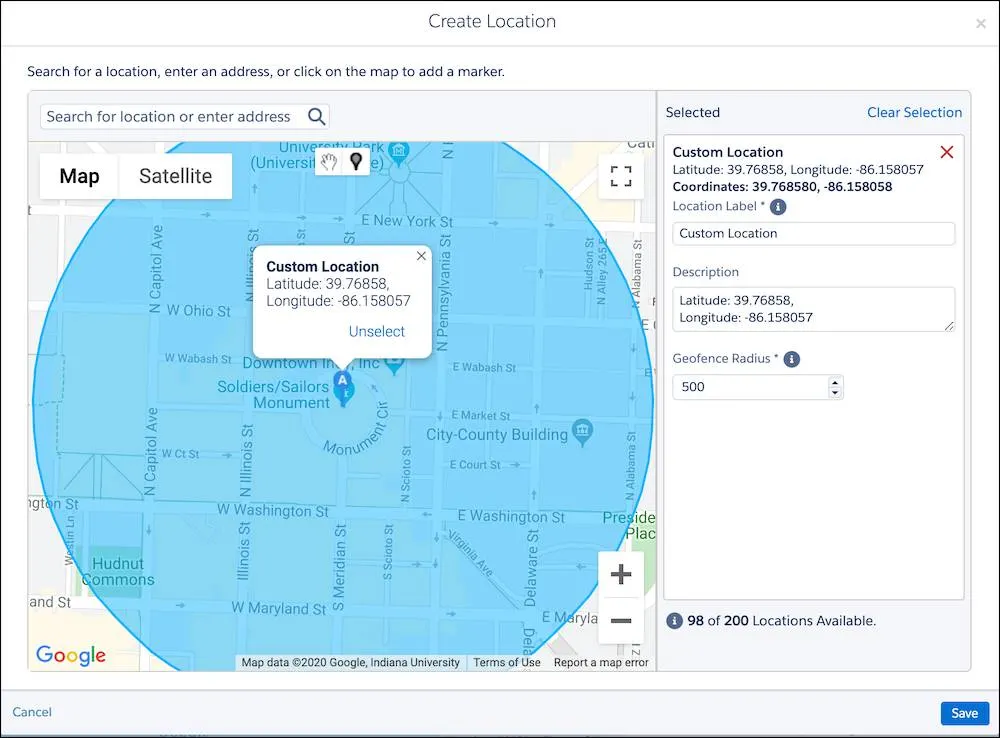By Martin H. Morrissette, Sirocco CMO – Book time with me
Picture this: You’re strolling through Stockholm’s Gamla Stan, phone in hand, when a notification pops up. It’s from your favourite coffee shop, just around the corner. “Special offer: 20% off your next latte!” it cheerfully declares. You glance up, and there it is the familiar storefront, beckoning you inside. That’s geo-fencing / location based marketing at work! A smart blend of strategy and technology that bridges the gap between physical and digital realms. And taking advantage of it might be easier than you think.
In this blog post, we’ll explore the art & science of geo-fencing marketing. Discover how businesses can strategically encircle their audience, delivering personalized messages and compelling ads precisely when and where it matters. But beware – the pitfalls are real, and we will guide you away from them. Plus, we’ve got stats that’ll make your ROI-loving heart skip a beat. So, grab your metaphorical map, and let’s navigate the exciting world of geo-fencing together!
Reaching the right audience at key moments
It’s finally Spring in Stockholm. Imagine a customer taking a leisurely walk through Djurgården, enjoying the sights and sounds of the city. As they approach a popular shopping district, a notification pops up on their phone. It’s from your boutique, announcing a flash sale with an exclusive 30% discount on all items for the next two hours. Intrigued and already in a shopping mood, the customer decides to take a detour and check out your store. This strategic approach leverages location data to deliver relevant messages at the opportune moment, significantly increasing the chances of conversion. By ensuring your message reaches potential customers exactly when they’re most receptive, you can effectively drive foot traffic and boost sales.
How does Geo-Fencing work, and how do you set it up?
Geo-fencing creates virtual boundaries around a specific location, like your store or even a competitor’s. When a mobile device with location services enabled enters this zone, pre-determined actions are initiated. This could be a notification showcasing your latest deals, a discount coupon, or simply a reminder of your presence nearby. The technology behind this magic lies in a combination of Wi-Fi, GPS, RFID (Radio Frequency Identification), and Bluetooth signals. Your marketing platform of choice may have geo-fencing capabilities ready to use without additional investments, making it not only a fun but cost-effective solution for businesses. The setup is pretty straightforward. If you have the geo-fencing feature enabled in your platform (e.g. Marketing Cloud), you specify the geofence location by address, GPS coordinates, or by dragging a pin onto the map. As a second step, you specify the size of the geofence, which is the radius of the circular boundary. Based on Apple and Google’s recommendations, when you’re setting up geo-fencing in your marketing platform, using a radius of at least 150 meters or 4-5min travel time is most impactful.
Before diving into campaign creation, we recommend taking a step back to strategically plan your geo-fencing approach. Here’s where customer journey mapping becomes crucial. Define your ideal customer profile and map their journey through the sales funnel. Consider where they might be located during different stages of their decision-making process. Are they browsing near competitors at the beginning of their search, or frequenting complementary businesses closer to purchase? Understanding these touchpoints allows you to set up targeted geo-fences and craft relevant messaging for each stage and scenario. Additionally, consider the user’s mindset and needs in each location. For example, someone browsing near your store might be receptive to a “welcome” message with a special offer, while someone near a competitor might benefit from a message highlighting your unique selling points. This strategic preparation ensures your geo-fencing campaigns deliver the right message at the right time, maximizing their impact.
Advantages of Geo-Fencing in your marketing
Geo-fencing offers numerous advantages for businesses. It allows you to reach users physically present in your target areas, eliminating wasted ad spend. By focusing your efforts on individuals within a specific geographic location, you can ensure that your marketing budget is used more efficiently, targeting only those most likely to convert. Additionally, you can expand your marketing reach by adding users who enter your geo-fence to your retargeting audience for future campaigns. This laser focus translates into efficient marketing spend and a targeted customer base.
Moreover, you can measure the effectiveness of your geo-fencing campaigns by tracking how many users who saw your ad actually visited your store. This data allows you to optimize your campaigns for maximum impact. By understanding which messages and offers resonate most with your audience, you can continually refine your approach for better results. Crafting messages that resonate with the user’s location context is another key advantage. For instance, promote a summer sale near your beach store in Malmö or a warm beverage ad near your cafe in Uppsala during winter. This level of personalization can significantly enhance customer engagement and loyalty.
The geo-fencing we are describing here is slightly different than the geo-targeting you may know from using Facebook Location Targeting, Google Ads Location Targeting, Instagram Locations & Geotags, and LinkedIn Geotargeting. Those typically cover larger areas (countries, cities, etc.) and sometimes can include specific types of locations, such as music venues or movie theatres, for example. Our team would be happy to explain the differences and opportunities with you during one of our strategising sessions.
Creative use cases for Geo-Fencing
The beauty of geo-fencing lies in its versatility. It’s a toolbox filled with possibilities to supercharge your marketing strategy. Here are some creative applications:
Taking competitor targeting to the next level: While capturing attention near competitors with irresistible offers is a powerful tactic, geo-fencing allows for even more strategic plays. Imagine a user lingering outside a high-end clothing boutique. A geo-fence around that area could trigger a notification showcasing your trendy, yet affordable selection across the street. This approach leverages the user’s existing interest in fashion and highlights your unique value proposition, enticing them to explore your store.
Expanding your reach during events: Target ads during major events like the Göteborg Book Fair or the Malmö Festival. But why stop there? During Melodifestivalen or Eurovision, create geo-fences around popular viewing areas like sports bars or outdoor screenings. These events attract large, diverse crowds interested in entertainment, food, or drinks. Imagine you offer delicious pizzas – a geo-fenced notification near these viewing areas could be the perfect way to target potential customers looking for a bite to complement the show.
Geo-conquesting with a focus on Unique Selling Points: Attract customers who frequent your competitors by showcasing your unique selling points. Let’s say your competitor is known for its extensive selection, while you specialize in organic products. A geo-fence around their store could trigger a notification highlighting your curated selection of local, farm-fresh produce. This approach targets users already primed for a purchase and steers them towards your store by emphasizing the value you offer that the competitor might lack.
Exit Offers: Re-engage users who have previously visited your location but haven’t converted yet. Imagine someone browsing your record store but leaving without a purchase. A geo-fence around the exit could trigger a notification for a discount on their favourite genre or a free download with any purchase. This serves as a gentle nudge to entice them to reconsider and potentially convert them into a customer.
Loyalty Builders: Reward loyal customers with special offers based on their location. A geo-fence around your store could trigger a notification for a birthday discount or points multiplier for users who have visited frequently. This personal touch demonstrates appreciation for their loyalty and incentivizes repeat business.
Traffic-Driven Promotions: During peak traffic hours, use geo-fences in high-congestion areas like train stations or busy streets to promote nearby services that can ease the wait, like a coffee shop or bookstore. This approach capitalizes on moments when people might be looking for ways to occupy their time, driving sales for your business.
Don’t forget the power of brand awareness! Raising brand awareness in specific high-traffic areas like Sergels Torg in Stockholm can also yield significant benefits. Think creatively and tailor your location-based messaging and advertising strategy to your unique business goals to unlock its full potential.
Avoiding common pitfalls
Geo-fencing, like any powerful tool, comes with its share of potential roadblocks. Imagine being bombarded with notifications—like that overly enthusiastic friend who texts you every hour. Don’t be that friend. Over-messaging is a pitfall to avoid. Maintain a strategic frequency to avoid annoying your audience. Privacy matters. Always. Think of user consent as an exclusive VIP guest list. Be transparent about data usage. No shady business here! Virtual fences are like picket lines around your campaign area. Precision matters. Double-check those coordinates. You don’t want to invite someone to a party they can’t find. Context is king. Picture promoting swimsuits during a snowstorm—it’s like selling ice to Eskimos. Instead, serve up that lunch special near an office building in Stockholm. Hungry workers will thank you.
Measurable success
The impact of geo-fencing on business performance (when implemented right) can be significant, especially when combined with other trigger-based campaigns. According to a study by Salesforce, businesses that implemented geo-fencing campaigns saw an impressive 68% increase in-store visits. Imagine more customers walking through your doors, all thanks to strategic location-based targeting. HubSpot reports that users who receive geo-targeted ads are 39% more likely to engage with the brand compared to untargeted audiences. This means location-based messaging can significantly enhance your brand’s visibility and engagement levels. Furthermore, BIA/Kelsey reports that 70% of consumers are willing to share their location if they believe they are receiving something of value in return, such as discounts or promotions. This willingness can be leveraged to create highly effective and engaging marketing campaigns. Additionally, a report by Verve Mobile highlights that geo-targeted mobile display advertising can deliver a 2x increase in click-through rates compared to traditional targeting methods.
Are you ready to harness the power of location?
Geofenced marketing can be a powerful tactic in your customer acquisition strategy. As a leading CRM business, we partner with several popular marketing solutions that support geo-fencing. Our teams possess the expertise to craft geo-fencing campaigns that deliver exceptional results. Let’s discuss how we can help you leverage the power of location to connect with your target audience. Book time with our CMO to get started or use the form below to book a demo on this or another topic!
Further reading: location-based messaging via Salesforce Trailhead











